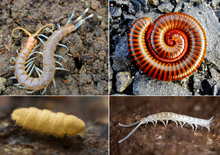|
Myriapoda
Myriapods (จาก กรีกโบราณ μυρίος (muríos) 'countless' และ πούς (poús) 'foot') เป็นสมาชิกของไฟลัมย่อย Myriapoda ซึ่งประกอบดด้วยสัตว์ขาปล้อง เช่น กิ้งกือ และ ตะขาบ กลุ่มนี้ประกอบด้วยสปีชีส์ประมาณ 13,000 ชนิด ซึ่งทั้งหมดอาศัยอยู่บนพื้นดิน[2] แม้ว่าหลักฐานทางโมเลกุลและฟอสซิลที่คล้ายกันจะแสดงการกระจายพันธุ์ในช่วงยุคแคมเบรียน[3][2] ฟอสซิลที่เก่าแก่ที่สุดของ Myriapoda พบได้ในช่วงระหว่าง Late Silurian และ Early Devonian[4][5] โดย Pneumodesmus เป็นหลักฐานแรกที่ค้นพบและทำให้ทราบการหายใจด้วยอากาศบนบก[6][7] ฟอสซิล Myriapoda อื่น ๆ ที่พบในช่วงเวลาใกล้เคียงกัน ได้แก่ Kampecaris obanensis และ Archidesmus sp.[8] การจัดจำแนกทางฟีโลเจนีของ Myriapoda ยังคงเป็นที่ถกเถียงกันอยู่ การศึกษาวิทยาศาสตร์เกี่ยวกับ Myriapoda เรียกว่า myriapodology และผู้ที่ศึกษา Myriapoda เรียกว่า myriapodologists[9] อ้างอิง
แหล่งข้อมูลอื่นวิกิสปีชีส์มีข้อมูลภาษาอังกฤษเกี่ยวกับ Myriapoda วิกิมีเดียคอมมอนส์มีสื่อที่เกี่ยวข้องกับ Myriapoda |
||||||||||||||||||||||||||||
Portal di Ensiklopedia Dunia
